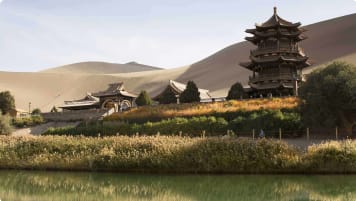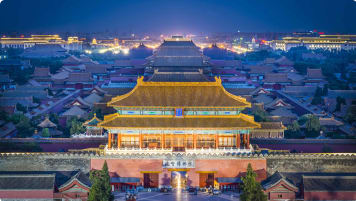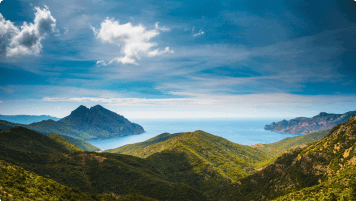Xi'an, the Beginning of the Silk Road: Definitive Guide for Travellers
Xi’an, the Beginning of the Silk Road The bustling city of Xi’an (“Western Peace”) in China‘s Shaanxi Province is one of China’s oldest cities and perhaps also its most culturally significant: as the ancient city…
29 Mar 19 · 8 mins read

Xi’an, the Beginning of the Silk Road
The bustling city of Xi’an (“Western Peace”) in China‘s Shaanxi Province is one of China’s oldest cities and perhaps also its most culturally significant: as the ancient city of Chang’an (“Perpetual Peace”) it served as capital of the Han dynasty, and was the starting point and eastern terminus of the historic Silk Road. In previous months we’ve written about the history of the Silk Road and the explorers who dug up treasures from the Silk Road cities. For this article, we will focus on the city of Chang’an and how it was built by China’s imperial dynasties, and shaped by trade and its diverse population throughout the Silk Road’s long history.
A City for a Millennium
Xi’an’s location near the Wei and Feng rivers contributed to its importance for about a millennium of Chinese history. Under the Western Zhou dynasty (1045 BC to ca 770 BC), the area was the twin capitals of Feng and Hao on either side of the Feng River. The succeeding Qin Dynasty (221 BC to 206 BC) was the first to rule over a truly unified China, and Emperor Qin Shi Huang established his capital just north of Xi’an’s current location, calling it Xianyang. The Great Wall of China was constructed and completed under the Qin Dynasty.

Emperor Qin’s reign was short-lived, lasting only 15 years, but his name might just be the most recognisable among China’s emperors for his army of Terracotta Warriors, which guard his tomb. To this day, travellers flock to Xi’an to walk around Emperor’s Qin’s tomb complex, one of the most famous archaeological finds in the world. The underground vault containing the warriors, bronze chariots, and horses was discovered fortuitously in 1974 by workers drilling a well.
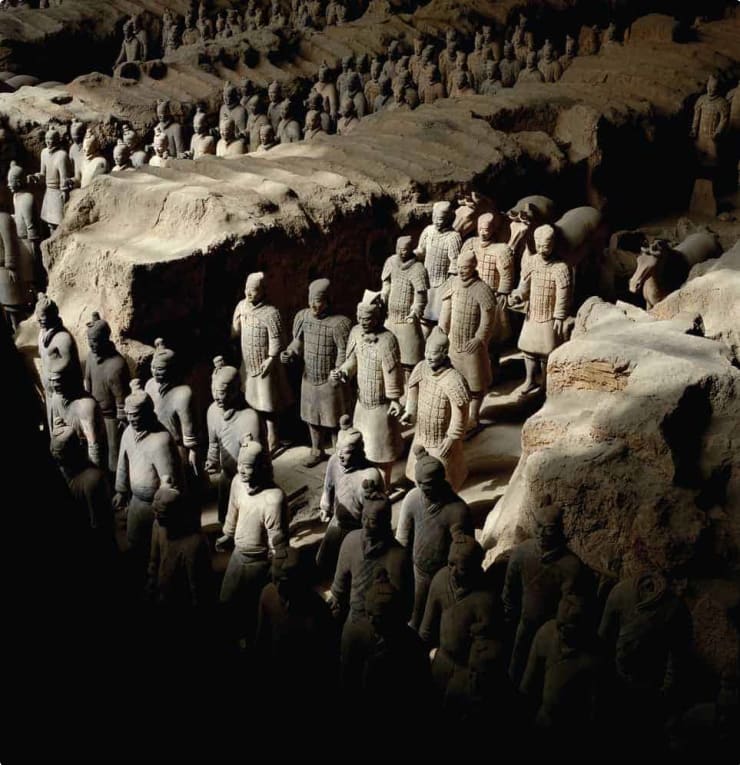
The Qin Dynasty collapsed shortly after Emperor Qin’s death, and Liu Bang, a minor official in the Qin court, swooped in to take the throne. After defeating his rivals, Liu Bang became Emperor Gaozu, the year 206 BC marking the beginning of the Han Dynasty’s long rule and the building of a great city.
Building the City of Chang’an
The Han Dynasty ruled its empire for 400 years, longer than any other Chinese dynasty. Emperor Gaozu established the imperial capital close to where Emperor Qin established his: just three kilometres northwest of modern-day Xi’an. The city, called Chang’an, was given an armoury and a state-controlled market and granary. Succeeding rulers would add more facilities, such as a market, mausoleum, and a police force. When Chang’an was founded, it had a population of 146,000.
Under the Han, Chang’an’s perimeter wall made of pounded earth had 12 entrances, and the city had eight main roads, with the middle lane (20 metres in width) reserved exclusively for the use of the emperor. There were three palace compounds: Changle Palace in the southeastern part of the city, which served as living quarters of the empress; Weiyang Palace in the southwestern side, where Han emperors met with city officials, and the Posterior Palace located north of Weiyang, which housed administration offices.
It would be the Han Dynasty’s fifth emperor who would change the city’s fate forever. Emperor Wu sent a mission in 138 BC, originally to form a diplomatic alliance, but ended up planting the seed for further travels that would establish the Silk Road. The establishment of the Silk Road was the Han Dynasty’s greatest achievement, bringing wealth and new cultures to China, and turning Chang’an into an important point of departure for the trade routes connecting the East to the West.
It was also under Emperor Wu’s reign when China assumed its modern territorial boundaries, while also incorporating northern Vietnam, Inner Mongolia, southern Manchuria, and most of Korea. Chinese calligraphy was refined into art, and Confucianism became the official state philosophy.
Emperor Wu ruled from 141 BC to 87 BC. Upon his death, the Han state, which had endured for four centuries and ushered in a cultural golden age, began to collapse. Chang’an was developed further by the early 1st-century Han ruler Wang Mang, who built an imperial ceremonial hall and several temples where China’s ancient kings were worshipped, and towns sprang up around the sites of the Qin and Han royal tombs, but this growth ceased when Chang’an was sacked in 23 AD. The siege was caused by a full-scale peasant rebellion in protest of unfair land ownership laws, forcing the relocation of the imperial capital to Luoyang. What followed was four more centuries of political turmoil, from 220 to 589.
Cosmopolitan Chang’an
According to Valerie Hansen’s The Silk Road: A New History (Oxford University Press, 2012), in 582, the short-lived Sui Dynasty relocated the capital back to Chang’an, and built a formally planned city (p. 147).
Under the Sui Dynasty, Chang’an was called Daxing and was designed by architect Yuwen Kai under Emperor Wen’s reign. Yuwen used a highly formal symmetry in designing the city, integrating elements of nature.
This layout was maintained by the Tang Dynasty, which reunified China in 618. Under the Tang, Chang’an served as imperial capital, save for brief intervals, for the next three centuries. This period is seen as China’s second high point after the Han Dynasty.
The Silk Road also reached its highest glory under the Tang Dynasty, extending northwards to the Mongolian plateau and southwards to the Tibet plateau. Tang Dynasty traditions were emulated by the Japanese, who even used Chang’an as a blueprint for the Japanese imperial cities of Nara and Kyoto.
Hansen (2012) describes the planned city as constructed under the Tang rulers. Walls with a height of 4.6 metres ran east to west and north to south, enclosing a rectangular area of 80 square kilometres, divided by broad avenues with the equivalent width of a “forty-five-lane highway” (p. 148). Outside the rectangle to the north of the city were the palace and government offices. Officials lived in the eastern half of the city, on larger tracts of land, while ordinary people lived in the western half, which tended to be more congested.
The markets were also divided: the Eastern Market specialised in domestic (Chinese) goods, while the Western Market had foreign goods, delivered by camel trains that travelled through the Silk Road. Shops selling the same goods clustered together in the same hang or row. Shares Hansen: “Even today, the Chinese word for expert is neihang, ‘inside the row’, and for a layman waihang, ‘outside the row’.”

During this time, Chang’an occupied an area seven times larger than modern-day Xi’an. Trade turned Chang’an into a cosmopolitan metropolis, opening its doors to thousands of foreigners who made homes inside the city’s defensive walls, deciding to settle in China as a result of treaties (p.149). Chang’an’s population hit the one million mark, with a sizeable foreign settlement who brought their religions and cultural practices with them. Chang’an visitors and residents in the 7th century enjoyed the same facilities we would now find in a modern city–restaurants, wine shops, warehouses, bank-like institutions, and inns (p. 148).
The city, at this point the most populous in the world, became a hub of art and culture, absorbing myriad international influences. Heather Colburn Clydesdale, writing for the Metropolitan Museum of Art, describes the treasures presented to the Tang emperor as tributes, and the fashion styles and practices that arrived in Chang’an through the Silk Road:
“…lions from Persia and rhinoceroses from Champa (a kingdom in south and central Vietnam), hawks from the Korean peninsula, ostriches sent by western Turks, sandalwood from the Indonesian archipelago, cardamom from the coast of the Malay peninsula, indigo from Samarkand, and wool from Tibet…[l]eopard-skin hats and close-fitting sleeves…[h]igh boots, practical for riding…short tunics…polo and archery contests, musical instruments and styles, and the scandalous Sogdian whirling dance[.]”
Sogdians in Chang’an
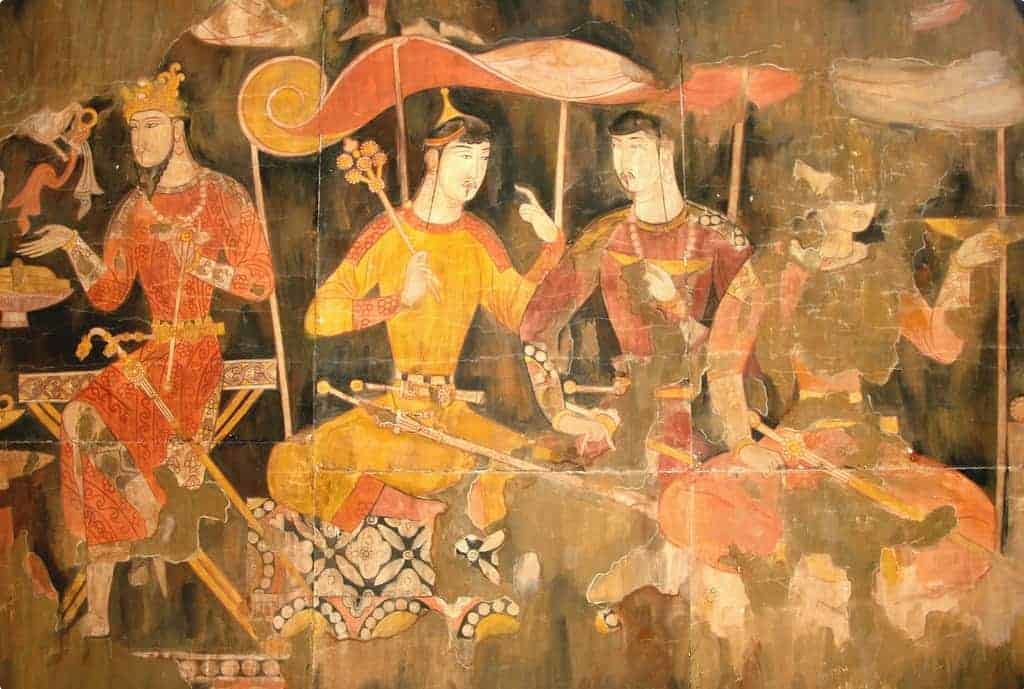
Sogdia was an ancient Iranian civilisation with territories located in present-day Tajikistan and Uzbekistan. The Sogdians constructed the famous oasis cities of Samarkand and Bukhara but are now quite unknown outside the circle of Silk Road specialists, following the disappearance of their historical identity in the 10th century. Sogdians fled to the far East from Alexander the Great’s military campaigns, and settled in China. Sogdian immigration to Chang’an reached its height around the 5th century, and the Sogdians rose to prominence as merchants, diplomats, and military leaders. They were great tradespeople and served important roles on the Silk Road trade routes.
Sogdian tombs have been uncovered in Xi’an. The discoveries show how immigrants to China “adjusted to and modified Chinese cultural practices” (Hansen, 2012, p. 143) as the tombs carried both Sogdian and Chinese elements and styles.
This relatively peaceful co-existence ended when An Lushan, a disgruntled Chinese military governor born to a Sogdian father (Hansen, 2012), led an anti-Tang rebellion that lasted a decade. An Lushan took Chang’an in 755 and declared himself emperor.
When the rebellion was finally quashed, the Tang Dynasty blamed the Sogdians and took measures against them, leading to “a new climate of intolerance” (p. 158) in Chang’an and the killing of Sogdians as well as non-Sogdians who were mistaken to belong to the minority group. Those who survived the killings changed their names and were forced to hide their Sogdian heritage.
Decline
The decade-long rebellion resulted in widespread destruction and loss of life, and weakened the Tang Dynasty, which was also fighting wars around its borders. In 877, a rebellion led by Chinese smuggler and soldier Huang Chao conquered Guangzhou. His group arrived in Chang’an in 881 to capture the imperial capital. The rebels burned down the Western Market and seized the palace (p.165), forcing the emperor to flee.
Government forces succeeded in defeating Huang Chao, but Chang’an would never recover its former glory. It would be attacked again in the 10th century by Zhu Quanchong, and the imperial capital would be moved back to Luoyang. The Tang Dynasty’s fall in 907 also spelled the decline of Chang’an and the Silk Road.
Tang poet Wei Zhuang mourned the lost city in one of his pieces:
Chang’an lies in mournful stillness: what does it now contain?
Ruined markets and desolate streets, in which ears of wheat are sprouting.

In later years, modernity would take the city back from the encroaching wilderness. Modern-day Xi’an still bears many traces of old Chang’an–its walls, palaces, and artefacts–which can still be viewed today, while archaeological excavations continue to reveal its Silk Road treasures.
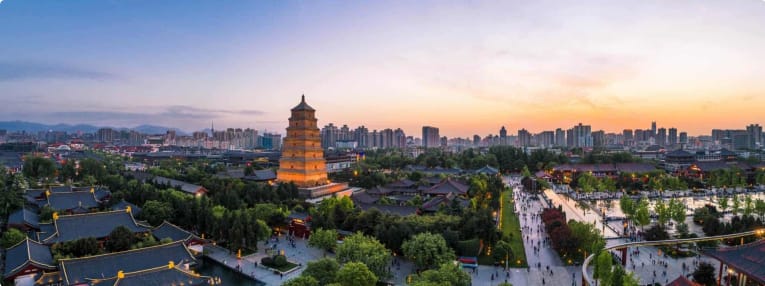
For more information, do read Valerie Hansen’s The Silk Road: A New History (Oxford University Press, 2012) particularly the chapter “The Cosmopolitan Terminus of the Silk Road”, as well as the other resources linked throughout this post.
If you want to learn more about the Silk Road, do join Odyssey Traveller’s 29-day Silk Road tour which begins in Xian (China) and ends in Tashkent (Uzbekistan). This fully escorted, small group tour is designed for the active senior traveller and takes participants to the oasis towns and archaeological sites on this ancient trade route. Click through to check the itinerary and sign up!
About Odyssey Traveller

Odyssey Traveller is committed to charitable activities that support the environment and cultural development of Australian and New Zealand communities. We specialise in educational small group tours for seniors, typically groups between six to fifteen people from Australia, New Zealand, USA, Canada and Britain. Odyssey Traveller has been offering this style of adventure and educational programs since 1983.
We are also pleased to announce that since 2012, Odyssey Traveller has been awarding $10,000 Equity & Merit Cash Scholarships each year. We award scholarships on the basis of academic performance and demonstrated financial need. We award at least one scholarship per year. We’re supported through our educational travel programs, and your participation helps Odyssey Traveller achieve its goals.
For more information on Odyssey Traveller and our educational small group tours, do visit and explore our website. Alternatively, please call or send an email. We’d love to hear from you!
Related Tours
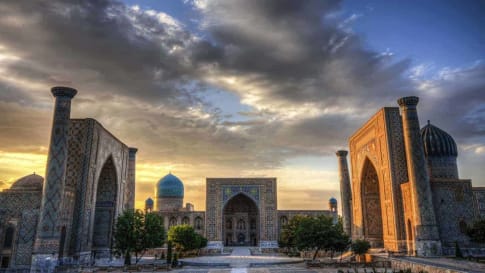
31 days
May, AugTravel on the Silk Road of Central Asia | Small Group Tour for Seniors
Visiting Kazakhstan, Kyrgyzstan
The Silk Road is an ancient trade route linking China and Imperial Rome through Central Asia. Few areas in the world remain as unexplored or offer such richness in terms of ancient and modern history, culture, and scenic diversity as Central Asia. Our Small group Silk road tours itinerary explores the Road through remote deserts and mountainous environments as we visit key sites between Almaty and through to Samarkand over 31 days.
From A$22,985 AUD
View Tour
29 days
Aug, May, SepTravel on the Silk Road with Odyssey Traveller | Small Group Tour for Seniors
Visiting China, Kyrgyzstan
The Silk Road is an ancient trade route linking China and Imperial Rome through Central Asia. Few areas in the world remain as unexplored or offer such richness in terms of ancient and modern history, culture, and scenic diversity as Central Asia. Our Small group Silk road tours itinerary explores the Road through remote deserts and mountainous environments as we visit key sites between Xi'an and Bukhara.
From A$19,685 AUD
View Tour